
Churches - Bevendean History Project

St Thomas the Apostle Church, Davigdor Road, BrightonThe
history of St. Thomas' church, like that of many churches in new
districts, was a record of progress under many difficulties. The
portion of St. Patrick's Parish bounded on the north by the Old
Shoreham Road and on the south by St. Anne's Well, was until the late
1800s, open country. By 1900 building development had begun, and the
Rev. R. Daniell Tyssen then Vicar of St. Patrick's felt it necessary to
make some spiritual provision for this outlying district. Messrs
Clayton and Black, the well-known Brighton architects were asked to
prepare plans.
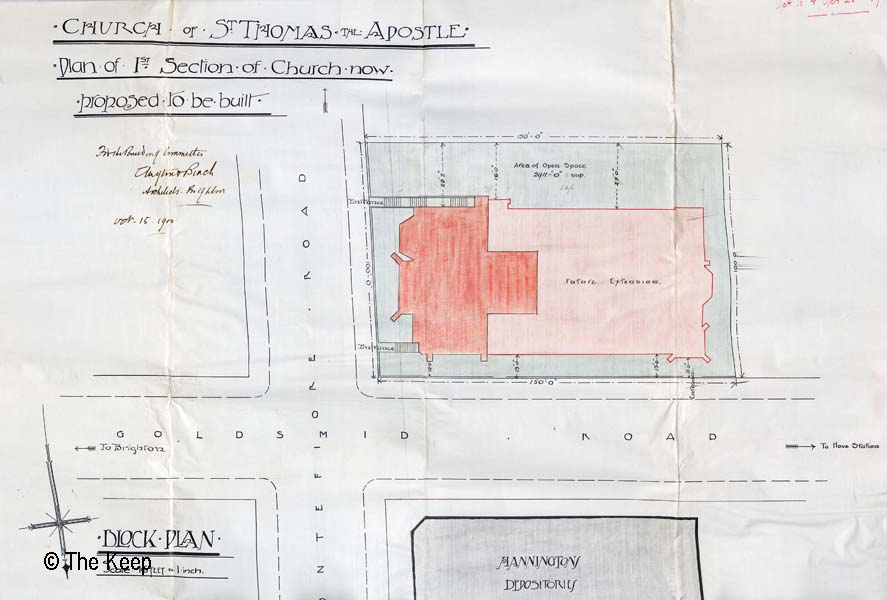
Block Plan showing the original part of the building dark red c1900.
Keep Ref: DO/C/6/2096.
The foundation stone of the Church of St. Thomas the Apostle was laid on Saturday 1 June 1901 by Alderman Howlett in the presence of a large gathering of clergy and laity. The Rev. R. D. Tyssen, pronounced the words of dedication and the Archdeacon of Lewes, Canon Sutton, gave the address, and said that the first part of the Church being built would accommodate 300 persons. The high level of the road above the site necessitated a Crypt under the proposed church and on 9 November 1901 the first area of the crypt was opened for worship. This was planned to become a Parish Hall when the Church, above the crypt, was completed. With the advent of the Rev. Walter Marshall in 1904, a fresh move was made. The original plans for a modest mission church were revised and the present magnificent church designed.
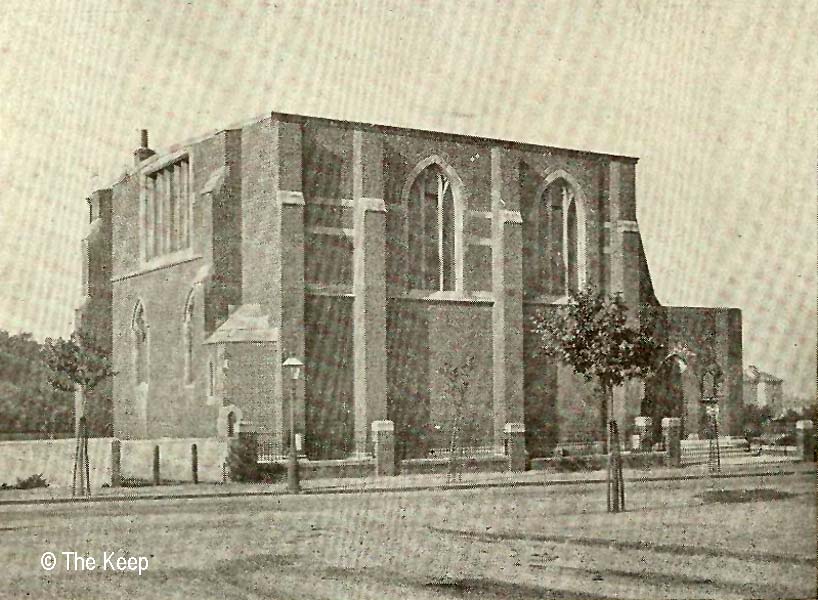
St Thomas the Apostle Church photographed 1908c.
Keep Ref: PAR 397/7/3/1.
The eastern bays of the church were built by 1907 and in 1913 it was decided to add three more bays to the existing building and complete the roof. The first portion of this new Church was opened in November 1907 but owing to lack of funds only two bays could be built with a flat temporary roof above the choir arches. This, building with its temporary walls and dilapidated appearance was for some years a bye-word for ugliness in Hove.
In 1909 the Rev. R. H. Domenichetti, at Mr. Marshall's request, took up the work. This year saw a large development of building on the Lyndhurst Estate, and a consequent increase of the population of the district. It soon became evident that enlargement of the church would be necessary but the task was a formidable one for a small congregation. It says much for the zeal and energy of the people that the large debt from previous building work was paid back in a year and the ground cleared to allow for enlargement.
A year later the Bishop, with a full approval of the Vicar of St. Patrick’s, in order to facilitate the eventual formation of St. Thomas' into a separate Parish, appointed the Rev. R. H. Domenichetti to the sole charge of the conventional District of St. Thomas, and from 1910 the church was self-supporting, and the stipend of the Priest in charge was paid out of the offertories of St. Thomas'. At the Bishop's earnest recommendation, the addition of three bays were ordered and in 1914 it was decided to complete the roof and so save the expense of temporary work and remove the reproach of the unfinished appearance of the building.
The total cost of the work to add three additional bays with the permanent roof, including lighting, heating, and Architect's Fees amounted to £9,800. The need of a church in this rapidly growing district was proved by the spiritual records of the past few years. In 1909 the total number of communions at all celebrations was under 2,000, and by 1914 these had reached a total of over 7,000. Organizations within the area had multiplied. The Parochial Guild has increased its membership and numbered over 60 members.
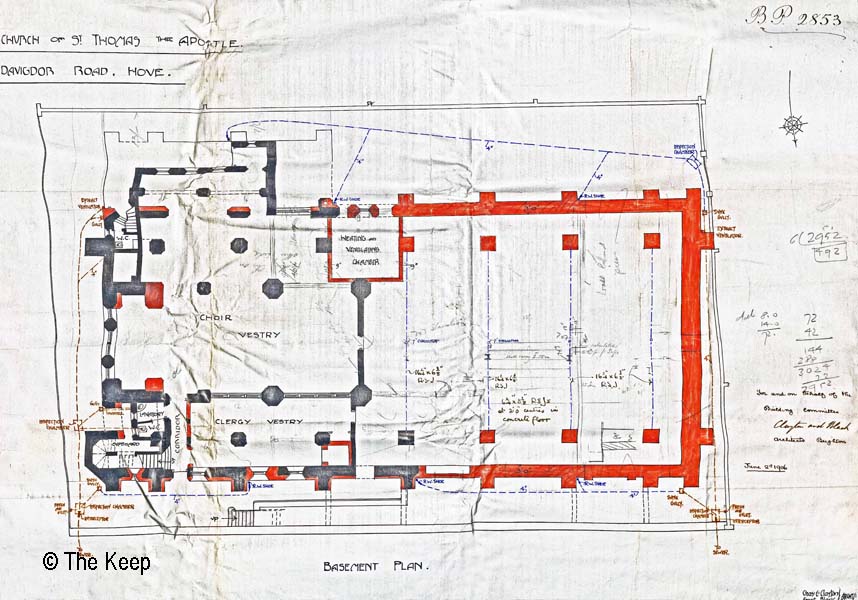
St Thomas the Apostle Church basement plan showing the additions to complete the church.
Keep Ref: DO/C/6/2096.
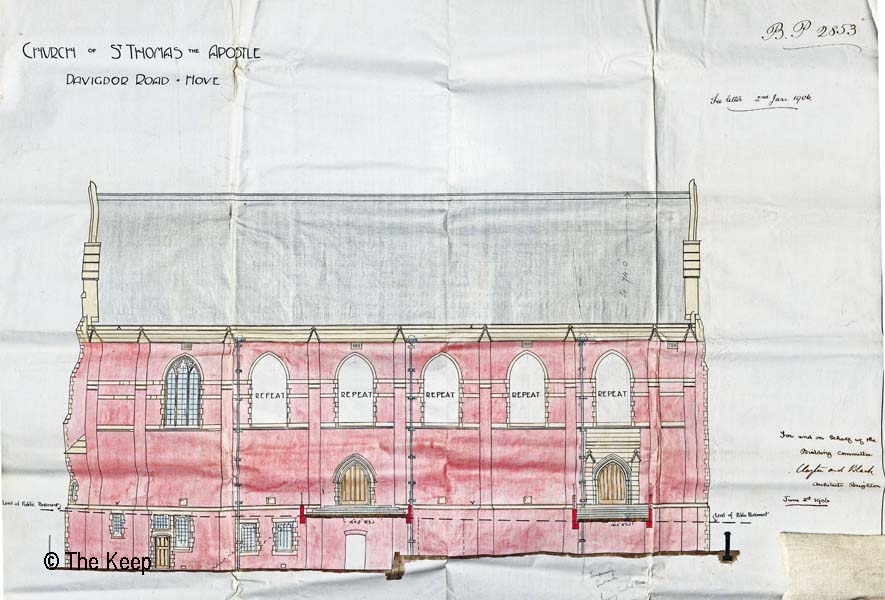
St Thomas the Apostle Church elevation plan showing the additions to complete the church.
Keep Ref: DO/C/6/2853.
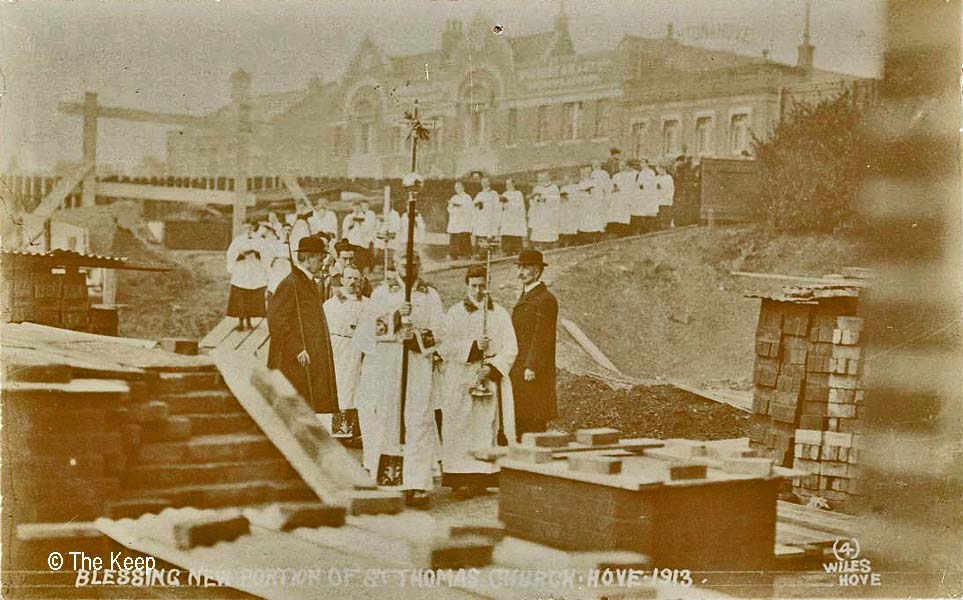
Blessing the new portion of St Thomas the Apostle Church in 1913.
Keep Ref: PAR 397/7/2/3.
The building was dedicated on 23 January 1915 by the Bishop of Chichester (Rt. Rev. Charles Ridgeway) and licensed for the solemnization of marriages on 6 October 1916. Finally, the church was consecrated on 17 January 1923. Although the area was originally a district in the parish of St Patrick's, a separate parish was created in 1924 out of the parishes of All Saints and St Patrick.

View towards sanctuary of St Thomas the Apostle Church in c1920.
Keep Ref: PAR 397/7/2/9.
A Vicarage with 5 bedrooms plus a maid’s bedroom was built on land at the south east corner of the church in Nizells Avenue and building was completed on 24 October 1928.
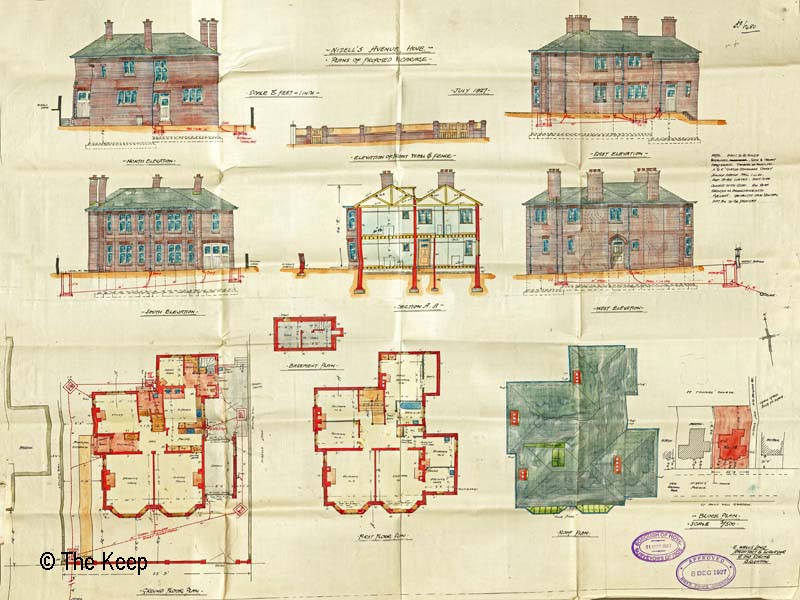
St Thomas Vicarage plans. Keep Ref: DO/C/6/6480.
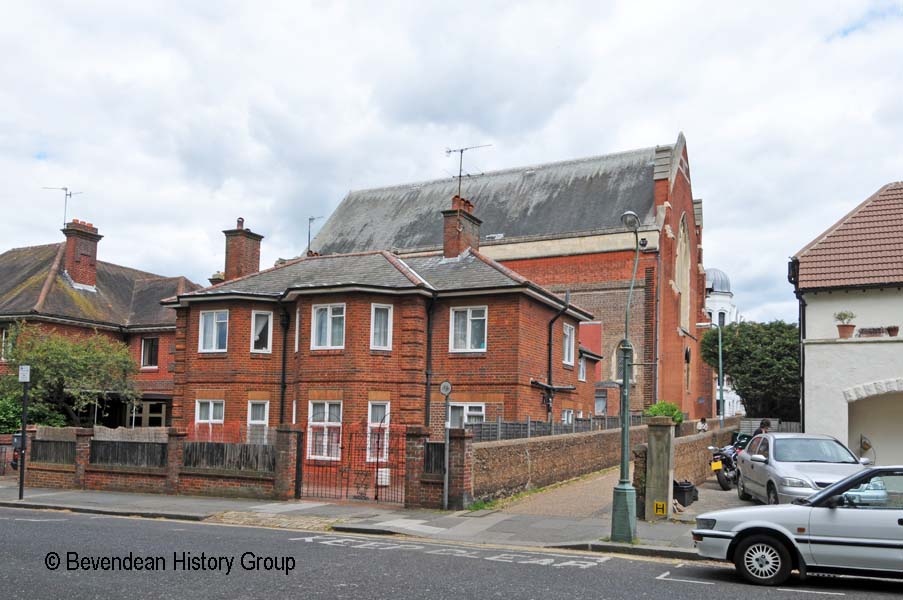
The former St Thomas the Apostle Vicarage built in Nizells Avenue, photographed in 2011. BHG Ref: 2011-05-14_DSC_4149.
In November 1965 November the Foundation Stone was recut in slate.
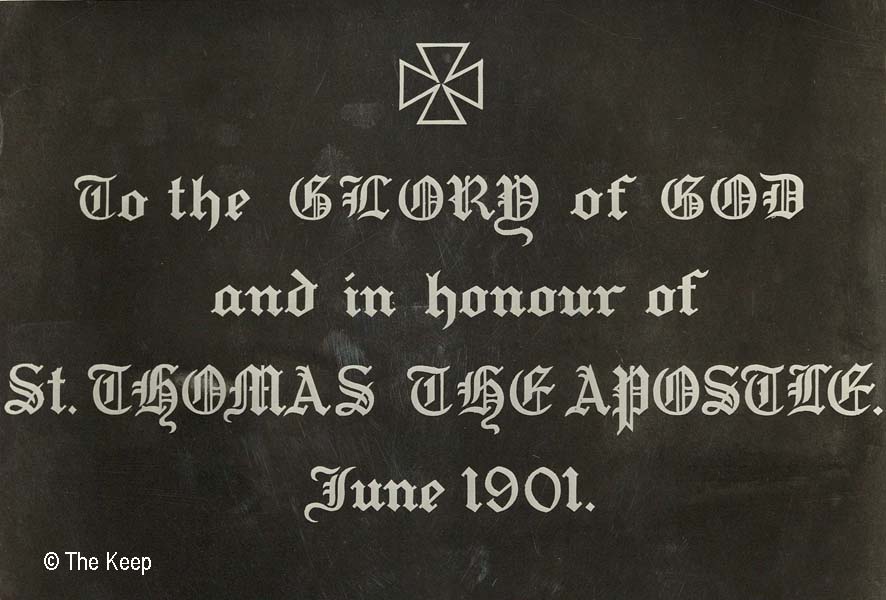
The recut Foundation Stone was dedicated on 19 June 1966.
Keep Ref: PAR 397/7/2/17.
The New Sacristy
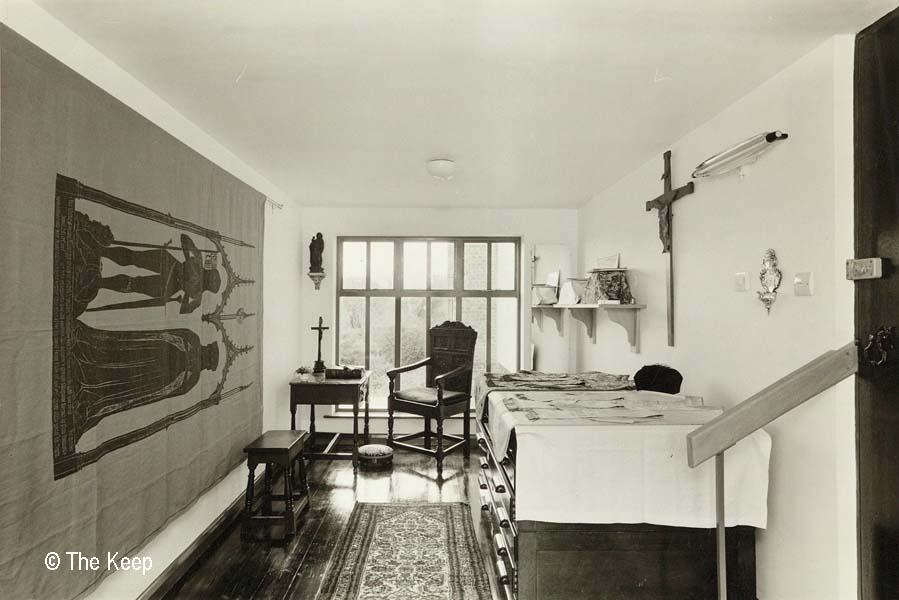
The New Sacristy c1967. Keep Ref: PAR 397/7/2/21.
As a result of a bequest from the late Mary Alicia Chell a new sacristy for the clergy was built on the south side and on the same level as the church. This was dedicated by the Bishop of Lewes on Sunday, 16 April 1967, and proved a most useful and convenient addition to the church.
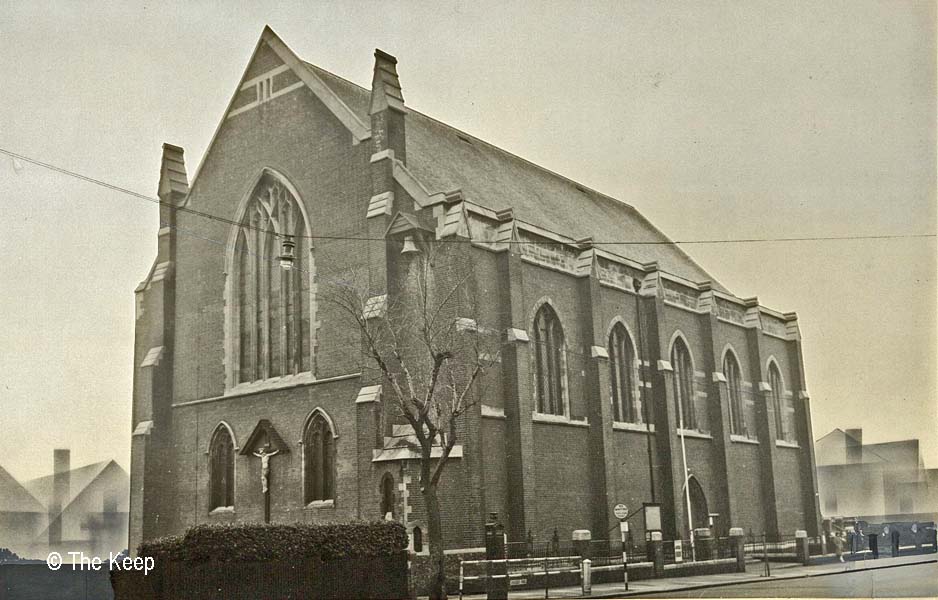
St Thomas the Apostle Church c1970. Keep Ref: PAR 397/7/2/22.
Sadly, the church was declared redundant by an order in Council on the 31st July 1993 and the order came into effect on 1 August 1993. The Parish was merged with the Parish of St Michael in Victoria Road.
The last marriage was solemnized on 2 May 1992.
The church was closed for worship on 17 January 1993 when the Bishop of Chichester the Right Reverent Eric Kemp presided at the final mass at 10.30 a.m.
However, the building, although no longer needed by the Anglican Church, was destined to remain as a house of God. Soon after its closure the building was bought by the Coptic Church and became the Church of St Mary and St Abraam. It was dedicated in September 1994 by the Pope of the Egyptian Coptic Church, Pope Shenouda III.
In Coptic churches there is a screen known as the iconostasis or icon bearer which separates the sanctuary from the main body of the church. The iconostasis in the Church of St Mary and St Abraam was carved in Cairo and then shipped to Sussex. It was put in place by 40 volunteers and weighs about one and a half tonnes. It is believed to be the world’s tallest such structure. At 7.5 metres high, and is made of French mahogany and American oak. There are 24 icons incorporated in the iconostasis, showing Christ, the Last Supper, the Apostles and several angels. According to church tradition the iconostasis is intended to stay in place until the return of Christ.

View of the Chancel with the Iconostasis and the entrance to the altar.
BHG Ref: 2011-05-14_DSC_4133
Around the building there are many other beautiful icons, and repositories for relics all of which have been brought from Egypt. The Coptic Church believes fully in the teachings of the Bible and uses unfermented wine in the service of the Lord's Supper.
The St Mary and St Abraam Church has a 2,000-strong congregation made up of mainly Egyptians and Sudanese people some of whom were delighted and proud to show us round their church.

Block Plan showing the original part of the building dark red c1900.
Keep Ref: DO/C/6/2096.
The foundation stone of the Church of St. Thomas the Apostle was laid on Saturday 1 June 1901 by Alderman Howlett in the presence of a large gathering of clergy and laity. The Rev. R. D. Tyssen, pronounced the words of dedication and the Archdeacon of Lewes, Canon Sutton, gave the address, and said that the first part of the Church being built would accommodate 300 persons. The high level of the road above the site necessitated a Crypt under the proposed church and on 9 November 1901 the first area of the crypt was opened for worship. This was planned to become a Parish Hall when the Church, above the crypt, was completed. With the advent of the Rev. Walter Marshall in 1904, a fresh move was made. The original plans for a modest mission church were revised and the present magnificent church designed.

St Thomas the Apostle Church photographed 1908c.
Keep Ref: PAR 397/7/3/1.
The eastern bays of the church were built by 1907 and in 1913 it was decided to add three more bays to the existing building and complete the roof. The first portion of this new Church was opened in November 1907 but owing to lack of funds only two bays could be built with a flat temporary roof above the choir arches. This, building with its temporary walls and dilapidated appearance was for some years a bye-word for ugliness in Hove.
In 1909 the Rev. R. H. Domenichetti, at Mr. Marshall's request, took up the work. This year saw a large development of building on the Lyndhurst Estate, and a consequent increase of the population of the district. It soon became evident that enlargement of the church would be necessary but the task was a formidable one for a small congregation. It says much for the zeal and energy of the people that the large debt from previous building work was paid back in a year and the ground cleared to allow for enlargement.
A year later the Bishop, with a full approval of the Vicar of St. Patrick’s, in order to facilitate the eventual formation of St. Thomas' into a separate Parish, appointed the Rev. R. H. Domenichetti to the sole charge of the conventional District of St. Thomas, and from 1910 the church was self-supporting, and the stipend of the Priest in charge was paid out of the offertories of St. Thomas'. At the Bishop's earnest recommendation, the addition of three bays were ordered and in 1914 it was decided to complete the roof and so save the expense of temporary work and remove the reproach of the unfinished appearance of the building.
The total cost of the work to add three additional bays with the permanent roof, including lighting, heating, and Architect's Fees amounted to £9,800. The need of a church in this rapidly growing district was proved by the spiritual records of the past few years. In 1909 the total number of communions at all celebrations was under 2,000, and by 1914 these had reached a total of over 7,000. Organizations within the area had multiplied. The Parochial Guild has increased its membership and numbered over 60 members.

St Thomas the Apostle Church basement plan showing the additions to complete the church.
Keep Ref: DO/C/6/2096.

St Thomas the Apostle Church elevation plan showing the additions to complete the church.
Keep Ref: DO/C/6/2853.

Blessing the new portion of St Thomas the Apostle Church in 1913.
Keep Ref: PAR 397/7/2/3.
The building was dedicated on 23 January 1915 by the Bishop of Chichester (Rt. Rev. Charles Ridgeway) and licensed for the solemnization of marriages on 6 October 1916. Finally, the church was consecrated on 17 January 1923. Although the area was originally a district in the parish of St Patrick's, a separate parish was created in 1924 out of the parishes of All Saints and St Patrick.

View towards sanctuary of St Thomas the Apostle Church in c1920.
Keep Ref: PAR 397/7/2/9.
A Vicarage with 5 bedrooms plus a maid’s bedroom was built on land at the south east corner of the church in Nizells Avenue and building was completed on 24 October 1928.

St Thomas Vicarage plans. Keep Ref: DO/C/6/6480.

The former St Thomas the Apostle Vicarage built in Nizells Avenue, photographed in 2011. BHG Ref: 2011-05-14_DSC_4149.
In November 1965 November the Foundation Stone was recut in slate.

The recut Foundation Stone was dedicated on 19 June 1966.
Keep Ref: PAR 397/7/2/17.
The New Sacristy

The New Sacristy c1967. Keep Ref: PAR 397/7/2/21.
As a result of a bequest from the late Mary Alicia Chell a new sacristy for the clergy was built on the south side and on the same level as the church. This was dedicated by the Bishop of Lewes on Sunday, 16 April 1967, and proved a most useful and convenient addition to the church.

St Thomas the Apostle Church c1970. Keep Ref: PAR 397/7/2/22.
Sadly, the church was declared redundant by an order in Council on the 31st July 1993 and the order came into effect on 1 August 1993. The Parish was merged with the Parish of St Michael in Victoria Road.
The last marriage was solemnized on 2 May 1992.
The church was closed for worship on 17 January 1993 when the Bishop of Chichester the Right Reverent Eric Kemp presided at the final mass at 10.30 a.m.
However, the building, although no longer needed by the Anglican Church, was destined to remain as a house of God. Soon after its closure the building was bought by the Coptic Church and became the Church of St Mary and St Abraam. It was dedicated in September 1994 by the Pope of the Egyptian Coptic Church, Pope Shenouda III.
In Coptic churches there is a screen known as the iconostasis or icon bearer which separates the sanctuary from the main body of the church. The iconostasis in the Church of St Mary and St Abraam was carved in Cairo and then shipped to Sussex. It was put in place by 40 volunteers and weighs about one and a half tonnes. It is believed to be the world’s tallest such structure. At 7.5 metres high, and is made of French mahogany and American oak. There are 24 icons incorporated in the iconostasis, showing Christ, the Last Supper, the Apostles and several angels. According to church tradition the iconostasis is intended to stay in place until the return of Christ.

View of the Chancel with the Iconostasis and the entrance to the altar.
BHG Ref: 2011-05-14_DSC_4133
Around the building there are many other beautiful icons, and repositories for relics all of which have been brought from Egypt. The Coptic Church believes fully in the teachings of the Bible and uses unfermented wine in the service of the Lord's Supper.
The St Mary and St Abraam Church has a 2,000-strong congregation made up of mainly Egyptians and Sudanese people some of whom were delighted and proud to show us round their church.
John Phillips
Plans and Photographs of St Thomas Church